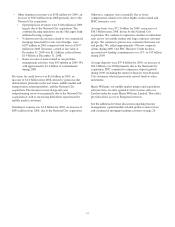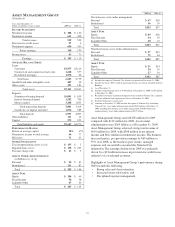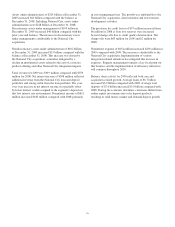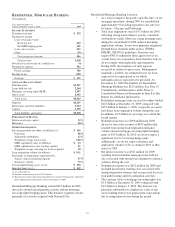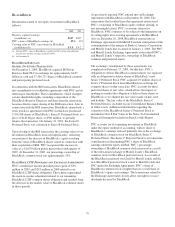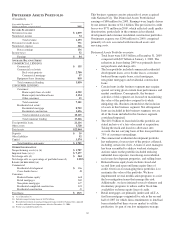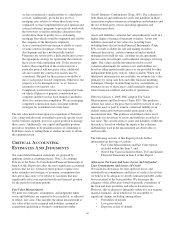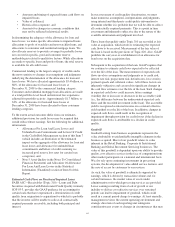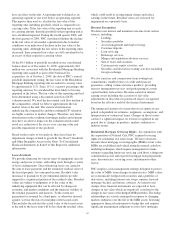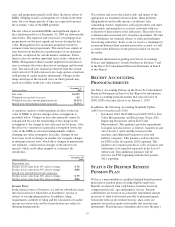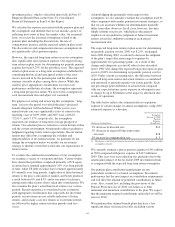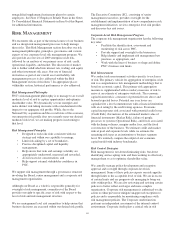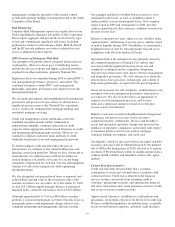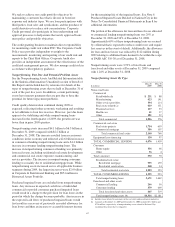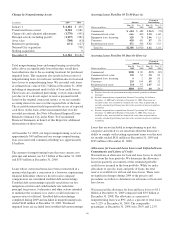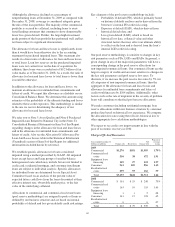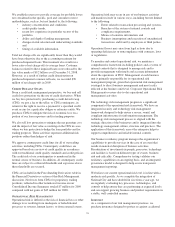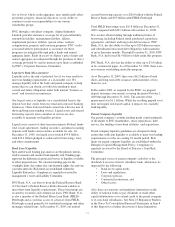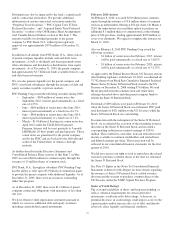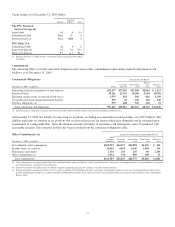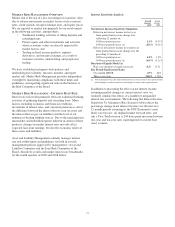PNC Bank 2009 Annual Report Download - page 68
Download and view the complete annual report
Please find page 68 of the 2009 PNC Bank annual report below. You can navigate through the pages in the report by either clicking on the pages listed below, or by using the keyword search tool below to find specific information within the annual report.
investment policy, which is described more fully in Note 15
Employee Benefit Plans in the Notes To Consolidated
Financial Statements in Item 8 of this Report.
We calculate the expense associated with the pension plan and
the assumptions and methods that we use include a policy of
reflecting trust assets at their fair market value. On an annual
basis, we review the actuarial assumptions related to the
pension plan, including the discount rate, the rate of
compensation increase and the expected return on plan assets.
The discount rate and compensation increase assumptions do
not significantly affect pension expense.
However, the expected long-term return on assets assumption
does significantly affect pension expense. Our expected long-
term return on plan assets for determining net periodic pension
expense has been 8.25% for the past three years. The expected
return on plan assets is a long-term assumption established by
considering historical and anticipated returns of the asset
classes invested in by the pension plan and the allocation
strategy currently in place among those classes. While this
analysis gives appropriate consideration to recent asset
performance and historical returns, the assumption represents
a long-term prospective return. We review this assumption at
each measurement date and adjust it if warranted.
For purposes of setting and reviewing this assumption, “long-
term” refers to the period over which the plan’s projected
benefit obligation will be disbursed. While year-to-year
annual returns can vary significantly (rates of return for the
reporting years of 2009, 2008, and 2007 were +20.61%,
-32.91%, and +7.57%, respectively), the assumption
represents our estimate of long-term average prospective
returns. Our selection process references certain historical data
and the current environment, but primarily utilizes qualitative
judgment regarding future return expectations. Recent annual
returns may differ but, recognizing the volatility and
unpredictability of investment returns, we generally do not
change the assumption unless we modify our investment
strategy or identify events that would alter our expectations of
future returns.
To evaluate the continued reasonableness of our assumption,
we examine a variety of viewpoints and data. Various studies
have shown that portfolios comprised primarily of US equity
securities have returned approximately 10% over long periods
of time, while US debt securities have returned approximately
6% annually over long periods. Application of these historical
returns to the plan’s allocation of equities and bonds produces
a result between 8% and 8.5% and is one point of reference,
among many other factors, that is taken into consideration. We
also examine the plan’s actual historical returns over various
periods. Recent experience is considered in our evaluation
with appropriate consideration that, especially for short time
periods, recent returns are not reliable indicators of future
returns, and in many cases low returns in recent time periods
are followed by higher returns in future periods (and vice
versa).
Acknowledging the potentially wide range for this
assumption, we also annually examine the assumption used by
other companies with similar pension investment strategies, so
that we can ascertain whether our determinations markedly
differ from other observers. In all cases, however, this data
simply informs our process, which places the greatest
emphasis on our qualitative judgment of future investment
returns, given the conditions existing at each annual
measurement date.
The expected long-term return on plan assets for determining
net periodic pension cost for 2009 was 8.25%, unchanged
from 2008. During 2010, we intend to decrease the midpoint
of the plan’s target allocation range for equities by
approximately five percentage points. As a result of this
change and taking into account all other factors described
above, PNC will change the expected long-term return on plan
assets to 8.00% for determining net periodic pension cost for
2010. Under current accounting rules, the difference between
expected long-term returns and actual returns is accumulated
and amortized to pension expense over future periods. Each
one percentage point difference in actual return compared
with our expected return causes expense in subsequent years
to change by up to $8 million as the impact is amortized into
results of operations.
The table below reflects the estimated effects on pension
expense of certain changes in annual assumptions, using 2010
estimated expense as a baseline.
Change in Assumption(a)
Estimated
Increase to 2010
Pension
Expense
(In millions)
.5% decrease in discount rate $10
.5% decrease in expected long-term return
on assets $18
.5% increase in compensation rate $ 3
(a) The impact is the effect of changing the specified assumption while holding all other
assumptions constant.
We currently estimate a pretax pension expense of $41 million
in 2010 compared with pretax expense of $117 million in
2009. This year-over-year reduction was primarily due to the
amortization impact of the favorable 2009 investment returns
as compared with the expected long-term return assumption.
Our pension plan contribution requirements are not
particularly sensitive to actuarial assumptions. Investment
performance has the most impact on contribution requirements
and will drive the amount of permitted contributions in future
years. Also, current law, including the provisions of the
Pension Protection Act of 2006, sets limits as to both
minimum and maximum contributions to the plan. We expect
that the minimum required contributions under the law will be
zero for 2010.
We maintain other defined benefit plans that have a less
significant effect on financial results, including various
64


